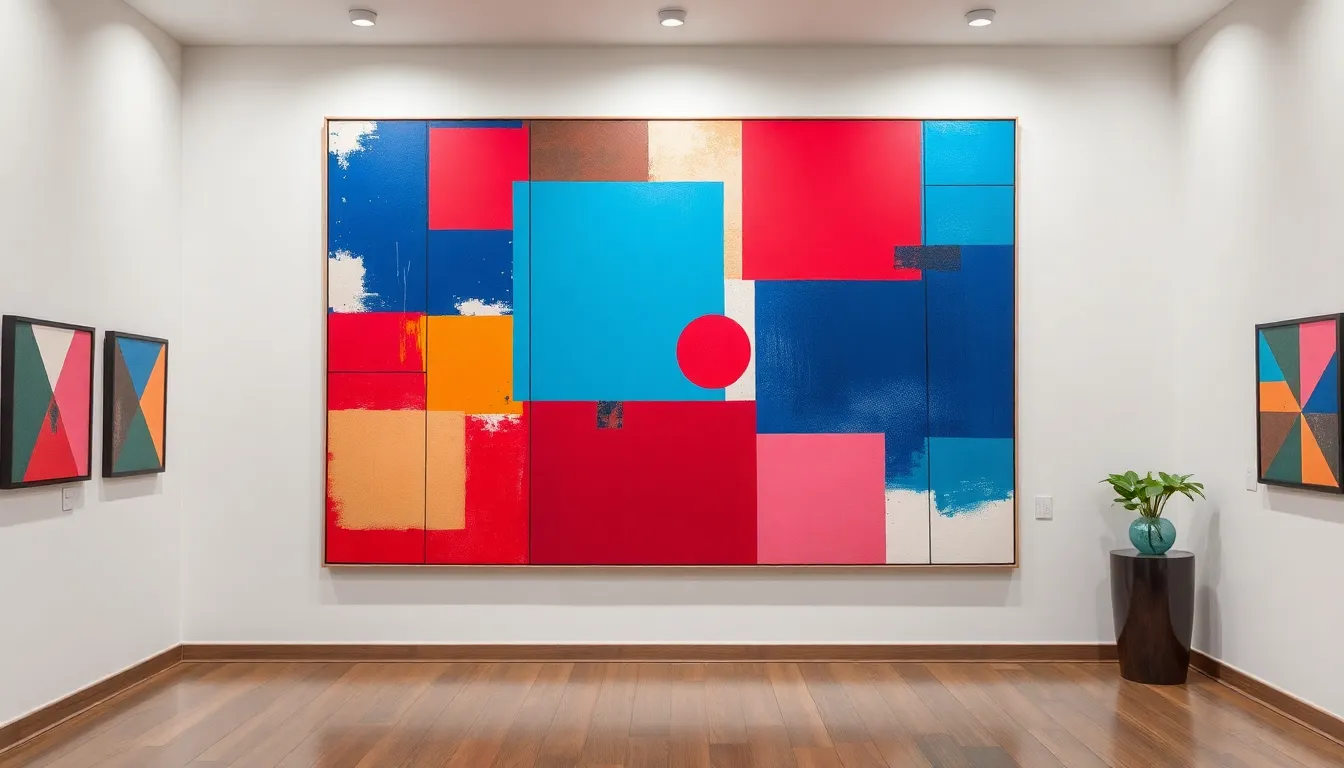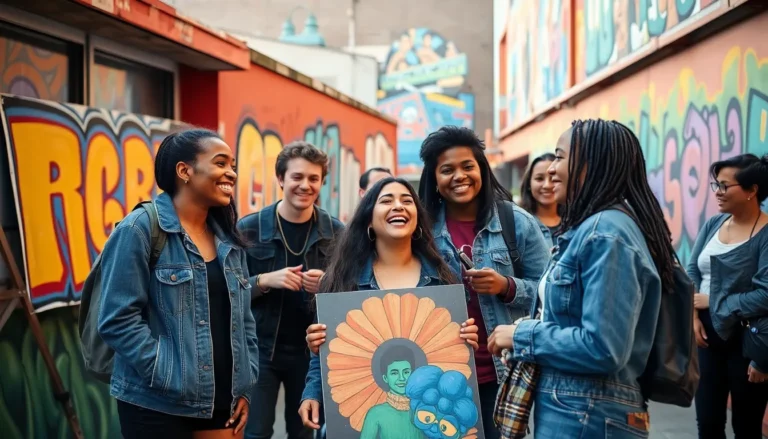Every artist knows that sometimes the canvas stares back like a judgmental cat. Finding inspiration can feel like hunting for a unicorn in a sea of paintbrushes. Yet, the world is bursting with ideas just waiting to splash onto that blank surface. Whether it’s nature’s vibrant colors or quirky everyday moments, inspiration is everywhere—if you know where to look.
Table of Contents
ToggleNature As Inspiration
Nature serves as a vast resource for artistic inspiration. It offers endless possibilities through its landscapes, flora, and fauna.
Landscape Painting Ideas
Landscape painting presents numerous opportunities for creativity. Artists can explore mountains, valleys, and coastlines, utilizing different times of day for varied light effects. Consider capturing serene sunsets or stormy skies to evoke emotion. Coastal scenes with crashing waves offer dynamic compositions, while tranquil forests create calming atmospheres. Each location provides unique colors and textures for artists to experiment with.
Flora and Fauna Themes
Flora and fauna inspire many painters with their diversity and beauty. Botanical elements like flowers and trees showcase vibrant colors and intricate patterns. Artists often paint close-ups of petals or leaves, highlighting details. Wildlife art, including birds and animals, adds another dimension. Capturing movement in animals or the delicate balance of ecosystems can create impactful pieces. Each theme encourages a deep connection with nature’s intricacies.
Abstract Inspiration

Abstract art offers endless possibilities for creative expression. Artists can draw inspiration from emotions, concepts, and forms that deviate from reality.
Color Combinations
Bold, unexpected color combinations can spark interest in abstract painting. Bright reds and deep blues create striking contrasts, while soft pastels produce calming effects. Eye-catching palettes foster emotional responses, whether vibrant or muted. For instance, pairing neon shades with earthy tones generates dynamic visual experiences. Consider experimenting with complementary colors to create balance and harmony in the composition. Unique color interactions can evoke distinct feelings, encouraging exploration beyond traditional methods.
Geometric Shapes
Geometric shapes serve as fundamental elements in abstract art, lending structure and interest. Squares, circles, and triangles can be arranged in various ways to create movement and rhythm. Combining different forms leads to exciting compositions that capture attention. Layering shapes adds depth, providing a three-dimensional quality to flat surfaces. Artists can also manipulate scale, placing larger shapes alongside smaller ones for dynamic visual contrasts. The interplay of simple shapes can convey complex emotions and concepts in the artwork.
Everyday Objects
Everyday objects offer a wealth of inspiration for artists. Capturing their essence can result in beautiful, relatable artwork.
Still Life Painting Ideas
Still life painting provides an opportunity to showcase ordinary items in a new light. Artists can arrange fruits, flowers, and even everyday utensils to create striking compositions. Consider elements like texture and light reflection when selecting subjects. Vibrant arrangements with contrasting colors create visual interest that draws the viewer’s eye. Displaying personal items can evoke emotions and tell stories, lending depth to the artwork.
Household Items as Subjects
Household items serve as excellent subjects for creative expression. Objects like teacups, books, and plants can be transformed into fascinating focal points. Experimenting with angles and distances adds a unique perspective to common items. Capture the simplicity of a candle’s flicker or the intricate patterns on a rug. By highlighting these items, artists can invite viewers to see beauty in the mundane, turning the ordinary into extraordinary.
Emotions and Concepts
Artists can draw inspiration from the formidable impact emotions and concepts have on their work. Both elements serve as a foundation for creating artwork that resonates with audiences.
Evoking Feelings Through Art
Art communicates emotions powerfully. Colors like red can evoke passion, while blue may inspire calmness. Using bold color palettes helps artists convey complex feelings effectively. Texture also plays a significant role; rough surfaces can invoke tension, and smooth finishes can offer serenity. Artists can create pieces that speak to viewers by exploring these emotional dimensions, allowing their artwork to resonate on a personal level.
Conceptual Themes to Explore
Conceptual themes open myriad avenues for creative expression. Artists may explore identity, freedom, or nature, each providing rich material for reflection and interpretation. Themes such as resilience or solitude can inspire profound connections, prompting viewers to engage deeply with the artwork. Using symbolism also enhances conceptual depth; every element can carry meaning that invites discussion. Artists thrive when they embrace these themes, capturing the essence of their ideas and emotions through their visuals.
Cultural Influences
Cultural influences play a significant role in shaping artistic expression. Diverse traditions and styles provide a wealth of inspiration for artists.
Traditional Art Forms
Traditional art forms often reflect the unique history and culture of a region. Techniques such as painting, pottery, and textile arts exhibit distinctive characteristics tied to cultural practices. Examples include Chinese ink wash painting, known for its fluid brushstrokes, and Navajo weaving, celebrated for its intricate patterns. Artists immerse themselves in these traditions to draw upon their beauty. Also, exploring cultural themes, such as mythology or folklore, enhances their work with depth and significance. By incorporating historical techniques and narratives, artists create pieces that resonate emotionally and culturally, connecting viewers with the past.
Modern Interpretations
Modern interpretations of cultural influences combine tradition with contemporary trends. Blending styles and techniques allows artists to express their identities in new ways. For instance, artists might merge street art with classical motifs, creating visually striking statements. Globalization introduces various artistic practices, encouraging cross-cultural collaboration. Waves of digital media also transform how artists engage with cultural elements. Inspired by technology, they can experiment with virtual reality or digital painting to reinterpret age-old themes. By embracing innovation, artists capture the essence of their cultures while reaching broader audiences.
Finding inspiration for painting doesn’t have to be a daunting task. By observing the world around them artists can unlock a treasure trove of ideas that spark creativity. From the beauty of nature and the intricacies of everyday objects to the depth of emotions and cultural influences there’s no shortage of subjects to explore.
Embracing these diverse sources allows artists to create meaningful and relatable artwork that resonates with viewers. By remaining open to inspiration in all its forms artists can transform their creative journeys into vibrant expressions of their unique perspectives.


